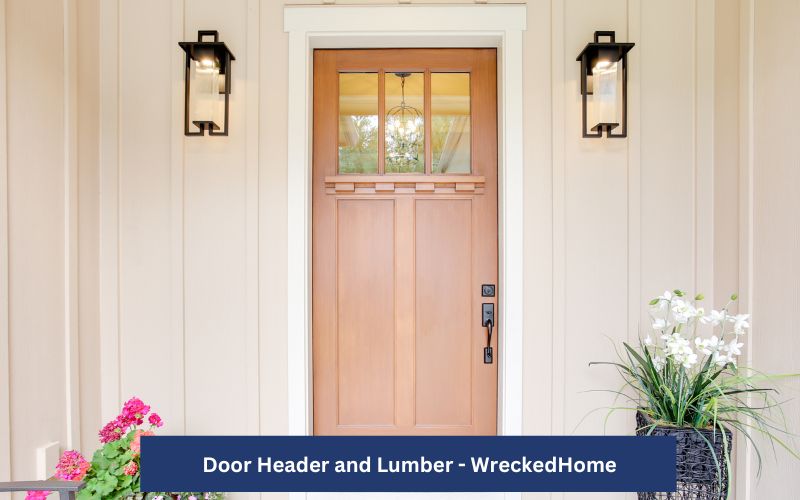In the realm of modern construction, door headers are far more important than just structural necessities. These seemingly simple pieces of wood span the width of a doorway; quite literally holding your home together.
From bearing loads, redistributing weight, and ensuring the structure, it is unsung hero of construction. Whether there is a guest welcoming door or an entry of your home, they serve as the backbone of every entryway. In this sense, door headers are the best thing that ensures both safety and functionality of your living spaces.
But the quality of your door headers is dependent on the lumber you choose for your door header. It plays a critical role in structural integrity and, aesthetic appeal of your doorway.
The right wood for a door header creates a difference in case of stands steadfast for years, and one that sags, cracks, or even fails. Your choice of lumber, is an important factor in an age where design and decor have become increasingly pivotal that complement your space’s architectural language or clash with it.
In this architectural journey, you’ll come to see that the topic of door headers is a harmonious blend of art and science. From understanding structural requirements to picking lumber that matches your stylistic vision, we will explore this crucial construction component. So whether you’re an experienced contractor or just curious about the intricacies of building design, this guide is for you.
Understanding Door Headers
A door header is a horizontal support beam situated at the top of a doorway, that is part of frame around a door. Its role is to distribute the weight of the structure above, channeling it to the vertical door jambs and eventually down to the bases of the door.
This weight redistribution keeps the door long-lasting and helps with standing under a stressful condition. This weight lifting behavior makes door headers indispensable in both residential and commercial buildings.
Over time, door headers become more and more modern from ancient civilizations stone lintels to span openings, more complex design for horizontal supports. If you are curious how to make an attractive and long lasting door header then must pay attention to wood.
We are going to explore a variety of materials and construction methods including single, double, and multiple ply options that help you in this regard.
Types of Door Headers
When it comes to door headers, there is not a single factor that is responsible for longevity and aesthetics. In contrast, there are different types of door header wood that depends upon factors like location, load-bearing requirements, and design aspirations. There are common types of wood that effect structural integrity of your construction but also its visual harmony.
- Single Ply Headers: In interior doorways there are low load-bearing requirements where Single Ply Headers are the best option. These types of headers consist of a single piece of lumber that are used in bedroom or bathroom doors. Their simple design and aesthetic look are typically more budget-friendly.
- Double Ply Headers: On the other hand, Double Ply Headers are suitable for exterior doors or any doorway that has to lift the heavy load. These headers provide an added layer of strength and stability, with two pieces of lumber fastened together at entry doors, garage doors, and windows. They increase overall integrity of the building by the use of two plies that offer managed weight lifting.
- Multiple Ply Headers: It consists of larger openings or unique design considerations for special cases. Multiple Ply Headers use three or more layers of lumber that you can customize to make your door front look more aesthetic. You can use it in special settings that blur the lines between indoor and outdoor living. This avant-garde architectural design offer better strength and the highest degree of customization.
You can choose the specific type according to function and requirements of your doorway. After knowing the right type and choosing best option you will understand the worth of the door header above your head than you might have thought.

Selecting the Right Lumber for Door Headers
Selecting the appropriate lumber for door headers is a decision that is based on form and function mutually. The wood you choose should be durable enough that it can handle the weight and stress placed upon it.
Quality, Strength, and Durability: the quality and strength are key factors of durability in door header wood. Do you think why wood should be durable? Because of weight bearing, and to face resisting environmental factors like moisture and pests.
- Softwood Lumber
One of the lumbers that is commonly used in door header is softwood. It includes 3 common types
- Pine: it is soft and easy to handle that come in very affordable price. But its delicate nature makes it prone to warping or bending. It is best for interior low weight doors that prefer aesthetics.
- Spruce: with its light weight and longevity nature it has fine grains and strength. These qualities make it suitable for both interior and standard exterior doors.
- Fir: It has a strong structural strength and resistance to warping that can bear heavy weight. You can use it in doorways where stability is paramount.
- Hardwood Lumber:
The second types of lumber that is hard to touch and strong in quality, known for its heavy lifting, is Hardwood Lumber. It consist of
- Oak: The strong grain makes it durable and long lasting by bearing heavy weight. Especially it’s well known in heavy traffic area door headers.
- Cherry: Interior doors in upscale homes or places made up of cherry rich color and elegant grain. Its best use is where aesthetics are vital.
- Maple: It is dense and resistant to wear in nature that it offers a consistent and subtle grain. You can use it in both indoor and outdoor places equally for strength and elegance.
- Engineered Lumber Options
For those who are looking for door header in commercial settings, then you must need to consider the engineered lumber option. That is
- Laminated Veneer Lumber (LVL): Laminated Veneer Lumber made up of wood veneers multiple layers that are bonded together. It provides uniform strength with superior load-bearing capacity and is less likely to warp or twist due to resistance to environmental stresses.
- I-beams: Often used in larger openings, they consist of top and bottom flanges with a vertical section, mimicking the shape of the letter “I.”
- Glued Laminated Timber (Glulam): Customizable in size and shape, the layers of lumber are bonded together with durable, moisture-resistant adhesives. It is the best option that is recommended for both straight and curved applications.
The right lumber for your door header is responsible for the natural aesthetic or pure strength. Therefore, understanding the properties and best uses of each wood type will help in selecting the right lumber.
Visit our store for 10% off our Tools here.
Factors to Consider When Choosing Lumber
When selecting lumber for door headers, you must know some of the key factors that lower risk of the wrong decision:
- Load-bearing capacity: Must ensure the weight capacity that your door header will bear. This is paramount. In this way understanding the load ensures you pick wood with the requisite strength.
- Location: for different locations, there are versatile requirements for strength and with stand. Consider interior and exterior settings along with weather requirements.
- Door Size: Door size with wider or shorter sizes has different preferences like the wider necessitating stronger or more layered wood choices.
- Aesthetic Considerations: Beyond functionality, a door’s material and appealing design is a key aspect of the door header for architecture.
- Budget Constraints: There are various cost-effective lumbers that offer a blend of strength and beauty. Without compromise on quality find the right balance.
Installation Best Practices for Door Headers
Installing a door header is not as simple as just putting wood above a doorway. It is a process that requires best practices and tools. Here are ways to install wood door headers successfully
Proper Measurement: The adage “measure twice, cut once” and fit it correctly. Do correct measurements for doorways, thickness of the jambs and any additional materials that will be used in the installation.
- Adhesive Solutions: The strength of a door header also depends upon the strong grip. Choose a strong bonding adhesive solution that enable strong fixing.
- Ensuring Level and Straight Placement: A header that is slightly skewed can be risky and lead to disruption. Therefore double check that the header is horizontal and measures from the corners. Use clamps to hold the header in the exact place that ensures successful installation.
- Safety Precautions: must wear safety gear that are goggles, gloves, and ear protection glasses or helmet. Must take assistance of someone as this is not an individual job.
By focusing on these practices you can ensure the successful installation and progress in project.
Conclusion
In conclusion, the lumber door header is offering aesthetic contributions and an essential base for your doorway. From choosing lumber to installing door header this is a decision based upon durability and the safety of the entire building structure.
Therefore, investing in quality lumber and adhering to best practices in installation are important for architecture and strong base. In contrast, the wrong decision or choice can lead to a terrible situation.
When you invest wisely in your door headers, you must consider both material and techniques. In this way you can invest in the safety and integrity of your home or building. Let’s use the assistance from this guide and make an informed decision.
For any repairs, installations, builds, or questions; We recommend you to hire a professional. Find A Pro Near You Here!





































